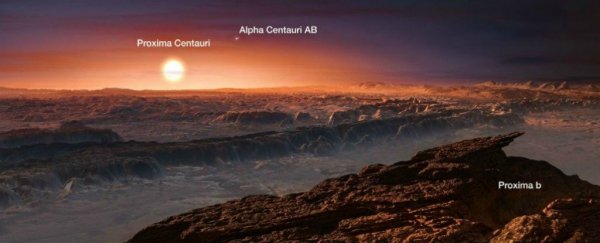Back in August, astronomers announced the discovery of what appears to be an Earthlike exoplanet orbiting Proxima Centauri - a red dwarf star in our closest neighbouring star system, Alpha Centauri.
Named Proxima b, the planet is just 4.25 light-years away, and there were early signs that it's rocky just like Earth, and is the right distance from its star to sustain liquid water. Now scientists have found evidence that it could in fact be "covered" in oceans of liquid water.
Just to put in perspective how cool the discovery of Proxima b was, before we found evidence of its Earthlike qualities, the closest known, potentially habitable exoplanet was Wolf 1061c - and it's 14 light-years away. That's 126 trillion kilometres from Earth.
Proxima b has since shifted that goalpost to just 4.25 light-years away, which is still 40 trillion km - or 271,000 times the distance from Earth to the Sun - but there's already a plan in place to get spacecraft there in 20 years.
To put it another way, this thing is so close to us, we can actually see two stars in its star system - Alpha Centauri A and Alpha Centauri B - in the night sky. In fact, Alpha Centauri A is the fourth-brightest star seen from Earth.
Exciting, right?
Now a team led by researchers at the Marseille Astrophysics Laboratory in France has strengthened the case of Proxima b's habitability by calculating a number of size and surface properties in more detail than ever before.
The picture those properties paint is a planet covered in liquid water oceans that could potentially sustain life.
"[T]he planet could be an 'ocean planet', with an ocean covering its entire surface, and similar water to some icy moons around Jupiter or Saturn," the team describes.
One of the biggest doubts scientists have had about Proxima b's habitability is the fact that it orbits relatively close to its star, Proxima Centauri.
It's estimated to orbit this star at a distance of 7.4 million km (4.6 million miles), which is a mere tenth of the distance that the closest planet to our Sun - Mercury - completes its rotations.
With highs of 427 Celsius (801 Fahrenheit) and lows of -173 Celsius (-279 Fahrenheit), Mercury isn't exactly the kind of place you're going to be looking for life, especially if you're hoping for liquid water.
The good news is that the Proxima Centauri star is different enough to our Sun to suggest that things might not be so harsh on Proxima b, but until recently, some scientists still weren't convinced that conditions would be right for water.
"Proxima Centauri … is a red dwarf just 0.1 percent as bright as the Sun and harbouring 12 percent the Sun's mass. That means the 'habitable zone' is 25 times closer in than the one surrounding our own Sun," Jesse Emspak explains for Space.com.
Planets that obit relatively close to their sun tend to become tidally locked, which means they always keep the same face toward their star.
As Emspak points out, scientists have come around to the idea that tidally locked planets could potentially be habitable in recent years, but it's been suggested that Proxima b might still be too hot to sustain liquid water.
To investigate this, the French team created simulations of the planet's composition based on its apparent size, and estimated that the radius of the planet is between 0.94 and 1.4 times that of Earth.
If we take that lowest limit, its radius would be roughly 5,990 kilometres, and the team's simulations suggested that in this scenario, the planet would be very dense, and contain a metallic core that makes up two-thirds of its total mass. That core would be surrounded by a rocky mantle.
"If there is surface water, it would not contribute more than 0.05 percent to the planet's total mass, the team said - similar to Earth, where it is about 0.02 percent," the AFP reports.
If we plug the highest radius limit into the simulations instead, the planet would have a maximum radius of 8,920 kilometres, and Proxima b's mass would be split 50-50 between a rocky centre and surrounding water.
"In this case, Proxima b would be covered by a single, liquid ocean 200 km deep," said the researchers told the AFP.
Both simulations suggest that the planet would have a thin, gassy atmosphere - something that's crucial for sustaining life as we know it - and temperatures would not rise above what's reasonable for liquid water to exist on its surface, despite being so close to its star.
"Contrary to what one might expect, such proximity does not necessarily mean that Proxima b's surface is too hot for water to exist in liquid form," the team said in a statement.
Of course, these are still just educated guesses, and we'll never know for sure what Proxima b's deal is until we actually get some equipment out there to measure these things.
Fortunately, there's already a mission being bankrolled by Russian billionaire Yuri Milner, called Breakthrough Starshot, which hopes to laser-propel 'nanocraft' towards Proxima Centauri some time in the next 20 years.
And NASA's James Webb Space Telescope (JWST), scheduled to launch in 2018, could give us some ideas about Proxima b's atmosphere by merely sampling the star system's light.
Let's just hope that once we do get some more concrete measurements, Proxima b ends up looking just as promising as it does right now.
The French team's research has been accepted for publication in an upcoming edition of The Astrophysical Journal Letters, but you can read it at the pre-print website, arXiv.org.
